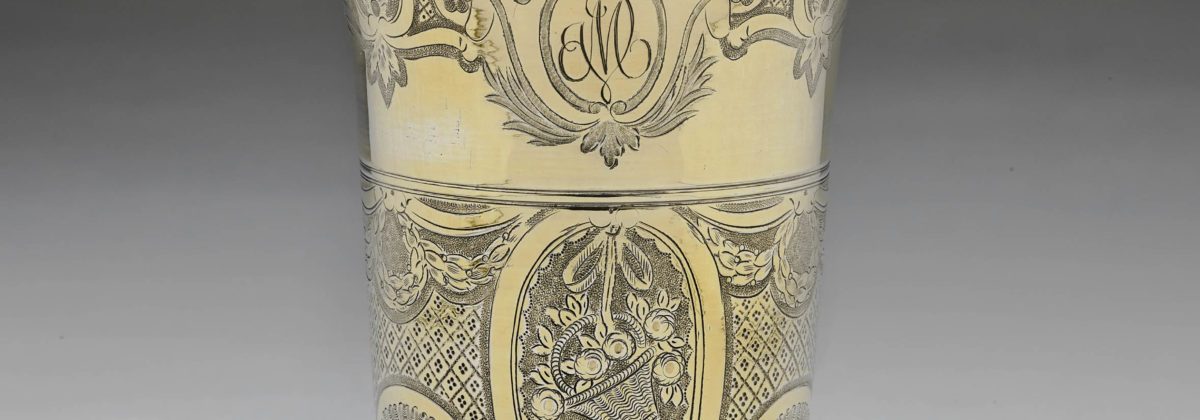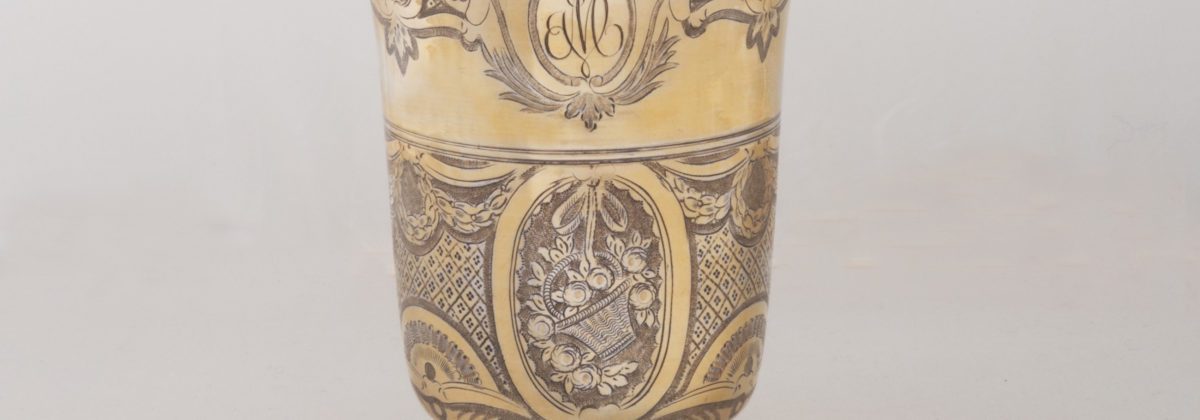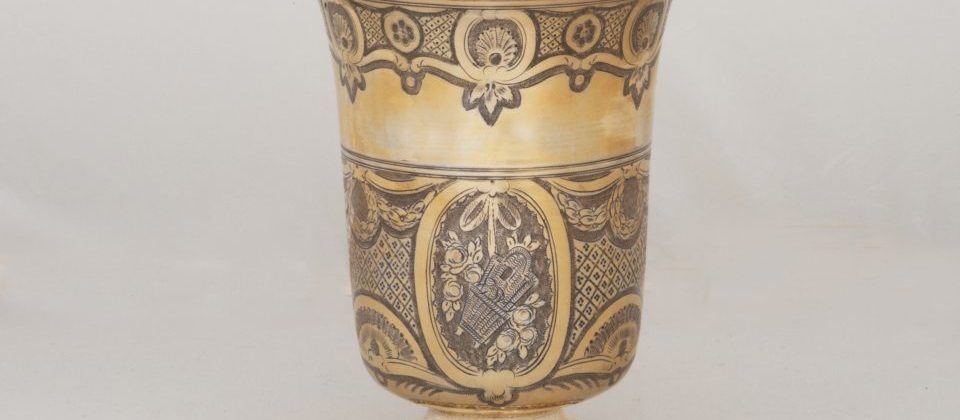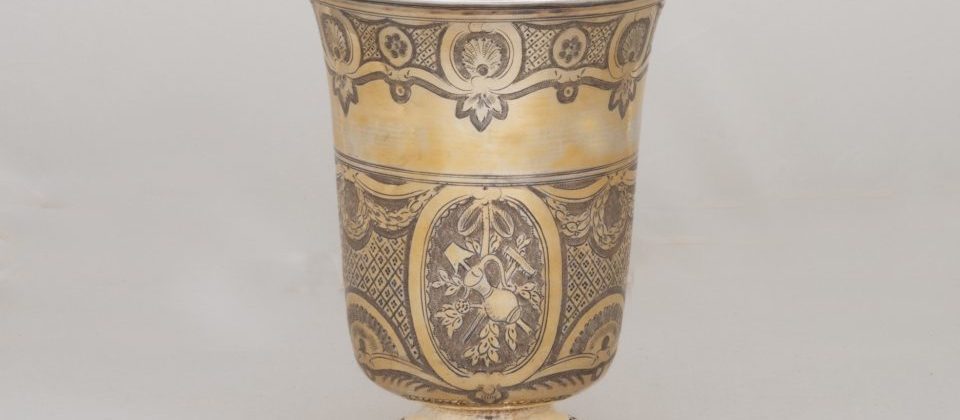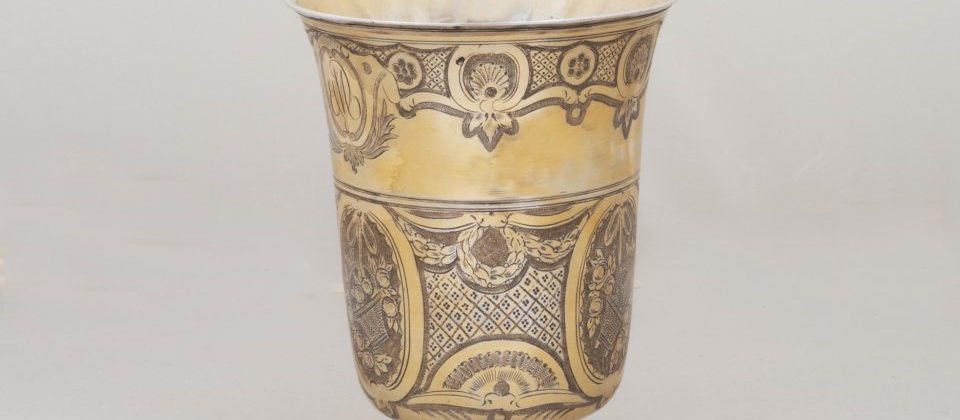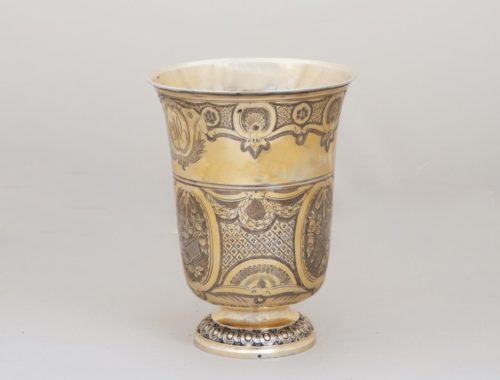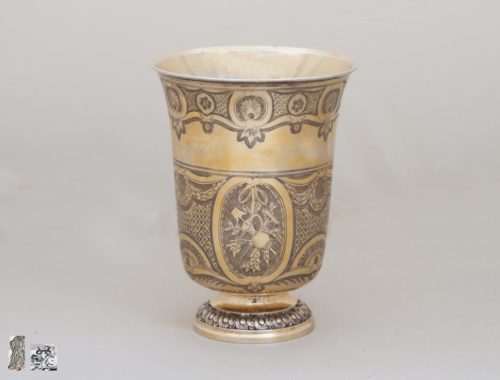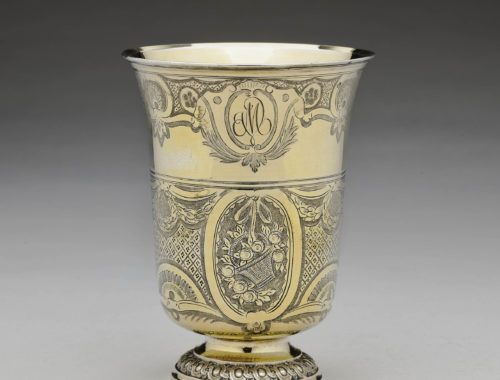Object Number: #264
Paris, 1779-1780
Denis Colombier
Maker’s Mark: Between „D“ and „C“ a Dove on a branch, crowned by a Fleur-de-lys between two dots for Denis Colombier (Nocq 1968, p.288; Carré 1929, p. 47).
Warden’s Mark: Crowned „A“ of the wardens Henri Clavel (active October 1st, 1780 – September 30th 1786) (Rosenberg (4) 1928, p. 260).
Height: 12,5 cm (4,92 in.); Weight: 214,7 gr.
Detailed Information
Silver-Gilt (Vermeil) French Beaker
The present beaker is a very nice and elaborated example of French silver from the end of the eighteenth century. On a round, slightly vaulted foot, the tulip-shaped corpus is tapering towards the upper side, adapting thus the shape of the beaker to the anatomy of the mouth.
The foot is decorated with an egg-shaped frieze, around which two slightly structured ribbons wrap around. The shaft connecting the standing ring and the cuppa is left plain. The exterior wall of the cup is very elaborately engraved. The rim is equipped with two rings. These are followed by a rich motif and alternating small and large medallions. Flowers are incorporated in the smaller ones, while in the larger a kind of rising sun depicted with its rays.
In the intermediate fields, there is a rich diapering work. The ornament closes in a waveband, which is enriched with a half-flower, among the larger medallions, and among the smaller medallions, with a small curl with a dot in the middle. This is followed by a smooth surface which ends with two rings. This is followed by diapering as the main decor of the beaker. In three large oval medallions are illustrated a back-basket and fruits, a basket and fruits as well as a watering ewer, spades, rakes and plants. In the oval above the basket with the fruits, the upper band is decorated with a rich decoration. This winds around the intricate initials “MV”.
Fields with sunrises are engraved between these agricultural representations. The space above the sun is decorated with diapering, but this time with four dots in the centre and crowned by braided leaf wreath. This decorative choice has probably a symbolical meaning, connecting the beaker with the ordering customer.
The elaborate decoration of this beaker as well as the initials indicate that this was made for a certain occasion, probably thanksgiving. The gilding as well as the engraving are in an excellent condition.
Tardy mentions a similarly elaborated cup in the collections of the musée des Arts décoratifs in Paris (Tardy 1962, p. II, fig. 2). In The Metropolitan Museum, New York, there is also a Parisian beaker of the same type.
Gold and Silver in France
Not only Paris but France in general, was a pioneer city in silverware production – religious and profane. During the Renaissance, the French court was a role model for art and culture. Influences from Italy were thereby decisive. However, much of the silver products have been melted down during wars and revolutions, or in times of financial shortage. Therefore, little has survived from the fifteenth and sixteenth centuries.
At the beginning of the eighteenth century the art of silversmith was flourishing in France as nobility and wealthy citizens gave many orders to the craftsmen. The various wars, however, forced a repeated melting down of silver, so that the silver stock of the early eighteenth century is not abundant. Nevertheless, the French silver has always been considered as being superb and was often a model for silver throughout Europe and beyond.
Maker
Denis Colombier was a maker in Paris. He began his apprenticeship with Henri Nicolas Debrie in 1763 and became a master maker in 1776. He mainly made drinking vessels. Today the works of Denis Colombier are preserved in the Metropolitan Museum of Art, New York and in George Washington’s Mount Vernon Museum as well as in private collections.
Literature
Karl Hernmarck: Die Kunst der europäischen Gold- und Silberschmiede von 1450-1830, München 1978.
Henry Nocq: Le poinçon de Paris. Répertoire des maîtres-orfèvres de la juridiction de Paris depuis le Moyen-Age jusqu’à la fin du XVIIIe siècle, Paris 1968.
Marc Rosenberg: Der Goldschmiede Merkzeichen (Band 4): Ausland und Byzanz, Frankfurt am Main 1928 (http://digi.ub.uni-heidelberg.de/diglit/rosenberg1928bd4, (last accessed on 05/03/2017).
Louis Carré: A Guide to Old French Plate. London 1929 (https://ia801704.us.archive.org/19/items/AGuideToOldFrenchPlate/CarreLouis-GuideToOldFrenchPlateA.pdf, (last accessed on 05/03/2017).


